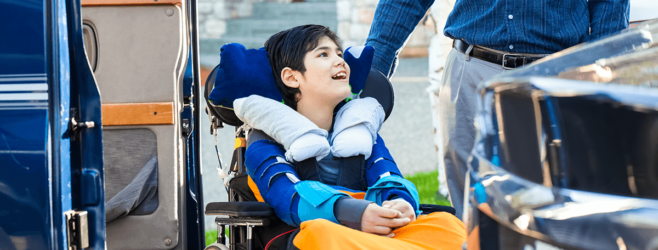As technology improves and funding sources increase, car modifications for cerebral palsy have become more accessible and commonplace. With new resources available, patients and caregivers can travel safer and more comfortably than ever before. Some people with cerebral palsy may even be able to drive a modified car.
What Are Car Modifications for Cerebral Palsy?
Cerebral palsy is a group of disorders that affects the brain’s control over muscles and the nervous system. It affects basic motor functions, which can prevent people from driving — and it can even prevent children from sitting safely in a car.
Car modifications for cerebral palsy can make travel possible for children living with the condition. It can even help adults gain independence by learning how to drive in modified cars.
One option for families who wish to make car modifications for a child with cerebral palsy is buying and installing adaptive equipment into an existing family vehicle. Families can also purchase a new vehicle already modified for kids with disabilities.
Types of Cerebral Palsy Car Modifications
Depending on how severe the child’s disability is, there are various cerebral palsy car modifications that families can make. The modifications must be made based on the child’s individual needs, including any adaptive equipment they rely on.
Car Seats
Specially designed car seats are available for children and young adults with disabilities. The seats provide the safety of traditional car seats while also providing clinical support to help with positioning.
These car seats are designed to stabilize the body while the vehicle is in motion, making rides more comfortable. The modified seats can also assist with transfers into and out of the vehicle.
Accessories such as buckle guards, incontinence covers, and seat extenders are also available.
Wheelchair-Adapted Cars
Since symptoms of cerebral palsy vary from person to person, some people may need to ride in a wheelchair. This could be because they are unable to control the movement of their legs or because they cannot reasonably be transferred from a wheelchair to a car seat.
In these instances, some cars, vans, and trucks may be adapted into wheelchair-accessible vehicles. It is critically important to follow safety guidelines when making car modifications for the disabled.
The modifications may also require supplementary equipment such as:
- Motorized wheelchair lifts
- Restraints to safely secure the wheelchair in position
- Wheelchair ramps
Can You Drive a Car if You Have Cerebral Palsy?
In some cases, adults with special needs can drive their own cars. First, comprehensive evaluations must take place to determine if a person can safely drive and, if so, what car modifications they may need.
Evaluations typically include examining:
- Ability to drive with adaptive equipment
- Coordination and reaction time
- Judgment and decision-making abilities
- Muscle strength, flexibility, and range of motion
If a disabled person is cleared to drive, required modifications may include:
- Automatic windshield wipers
- Gas pedal accelerators
- Gas tank aids
- Hand controls
- Handles to assist in getting in and out of vehicles
- Keyholders to provide better leverage
- Steering knobs
- Swiveling car cushions to help turn the seat when getting in and out
Cost of Car Modifications for Cerebral Palsy
The cost of car modifications for the disabled can vary greatly. Costs depend upon the type of disability, as those with more severe conditions may need vehicles to be modified significantly.
Some equipment, such as seat cushions can cost as little as $50. However, hand controls may cost closer to $1,000.
Costs to families will also depend on whether the family is buying a new car or using one they already own. A new vehicle made with modifications for the disabled may cost anywhere between $20,000-$80,000.
Affording Car Modifications for Cerebral Palsy
Although car modifications for cerebral palsy can be very expensive, families may have options that can help them afford such important assistance.
GoFundMe is an online fundraising platform that allows people in need to share their story and request donations from large crowds of people through the internet. Many families have set-up GoFundMe pages seeking funds for car modifications for the disabled.
Advocacy groups and nonprofits may provide funds to offer relief to children in need. Generally, these groups offer funds locally, such as PG Kids in South Florida. To learn about local programs, families may contact their office of state government that handles services for the disabled.
State or federal programs, such as the State Department of Vocational Rehabilitation, may help pay part or all of the cost of car modifications. The U.S. Department of Veterans Affairs (VA) is also available to provide assistance to military veterans and their families.
Other financial assistance options to investigate may include:
- Auto insurance sometimes pays for equipment needed for injuries that are a result of a car crash
- Vehicle manufacturers usually offer a rebate for adaptive equipment of up to $1,000 if a vehicle less than one-year-old is purchased
- Some states waive sales tax for adaptive devices
- Adaptive equipment may be tax-deductible
Car modifications for cerebral palsy can be of vital importance to families. There are many challenges that transporting children and adults with disabilities can create. With properly modified vehicles, people with disabilities can travel safely and comfortably.



